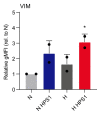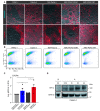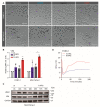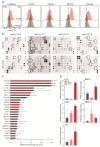Soluble Compounds Released by Hypoxic Stroma Confer Invasive Properties to Pancreatic Ductal Adenocarcinoma
- PMID: 33105540
- PMCID: PMC7690284
- DOI: 10.3390/biomedicines8110444
Soluble Compounds Released by Hypoxic Stroma Confer Invasive Properties to Pancreatic Ductal Adenocarcinoma
Abstract
Pancreatic ductal adenocarcinoma (PDAC) is characterized by abundant stroma and a hypoxic microenvironment. Pancreatic stellate cells (PSC) are activated by hypoxia and promote excessive desmoplasia, further contributing to the development of hypoxia. We aimed to explore how hypoxia and stroma interact to contribute to invasive growth in PDAC. [18F]HX4 PET/CT was found to be a feasible non-invasive method to assess tumor hypoxia in 42 patients and correlated with HIF1α immunohistochemistry in matched surgical specimens. [18F]HX4 uptake and HIF1α were strong prognostic markers for overall survival. Co-culture and medium transfer experiments demonstrated that hypoxic PSCs and their supernatant induce upregulation of mesenchymal markers in tumor cells, and that hypoxia-induced stromal factors drive invasive growth in hypoxic PDACs. Through stepwise selection, stromal MMP10 was identified as the most likely candidate responsible for this. In conclusion, hypoxia-activated PSCs promote the invasiveness of PDAC through paracrine signaling. The identification of PSC-derived MMP10 may provide a lead to develop novel stroma-targeting therapies.
Keywords: epithelial-to-mesenchymal transition; hypoxia; pancreatic ductal adenocarcinoma; pancreatic stellate cells; stroma.
Conflict of interest statement
HWML has acted as a consultant for BMS, Eli Lilly and Company, MSD, Nordic Pharma Group/Taiho, and Servier, and has received unrestricted research grants from Amgen, Bayer Schering Pharma AG, BMS, Celgene, Eli Lilly and Company, GlaxoSmithKline Pharmaceuticals, MSD, Nordic Pharma Group, Philips, and Roche Pharmaceuticals. MFB has received research funding from Celgene and acted as a consultant to Servier. MGB has received research funding form Ethicon, Medtronic, and Mylan. None of these companies were involved in the design, conduct, or analysis of this study or drafting of the manuscript and decision to publish.
Figures








Similar articles
-
Resveratrol Ameliorates the Malignant Progression of Pancreatic Cancer by Inhibiting Hypoxia-induced Pancreatic Stellate Cell Activation.Cell Transplant. 2020 Jan-Dec;29:963689720929987. doi: 10.1177/0963689720929987. Cell Transplant. 2020. PMID: 32463297 Free PMC article.
-
High-grade mesenchymal pancreatic ductal adenocarcinoma drives stromal deactivation through CSF-1.EMBO Rep. 2020 May 6;21(5):e48780. doi: 10.15252/embr.201948780. Epub 2020 Mar 16. EMBO Rep. 2020. PMID: 32173982 Free PMC article.
-
Stromal heterogeneity in pancreatic cancer and chronic pancreatitis.Pancreatology. 2018 Jul;18(5):536-549. doi: 10.1016/j.pan.2018.05.004. Epub 2018 May 12. Pancreatology. 2018. PMID: 29778400
-
Persistent activation of pancreatic stellate cells creates a microenvironment favorable for the malignant behavior of pancreatic ductal adenocarcinoma.Int J Cancer. 2013 Mar 1;132(5):993-1003. doi: 10.1002/ijc.27715. Epub 2012 Oct 5. Int J Cancer. 2013. PMID: 22777597 Review.
-
The Role of Stellate Cells in Pancreatic Ductal Adenocarcinoma: Targeting Perspectives.Front Oncol. 2021 Jan 14;10:621937. doi: 10.3389/fonc.2020.621937. eCollection 2020. Front Oncol. 2021. PMID: 33520728 Free PMC article. Review.
Cited by
-
Therapeutic potential of chrysin nanoparticle-mediation inhibition of succinate dehydrogenase and ubiquinone oxidoreductase in pancreatic and lung adenocarcinoma.Eur J Med Res. 2022 Sep 8;27(1):172. doi: 10.1186/s40001-022-00803-y. Eur J Med Res. 2022. PMID: 36076266 Free PMC article. Review.
-
The contributions of hypoxia to poor outcomes in pancreatic cancer.Transl Cancer Res. 2022 Nov;11(11):3935-3937. doi: 10.21037/tcr-22-2167. Transl Cancer Res. 2022. PMID: 36523300 Free PMC article. No abstract available.
-
Pancreatic stellate cells - rising stars in pancreatic pathologies.Physiol Res. 2021 Dec 30;70(Suppl4):S597-S616. doi: 10.33549/physiolres.934783. Physiol Res. 2021. PMID: 35199546 Free PMC article. Review.
-
An Eight-Gene Hypoxia Signature Predicts Survival in Pancreatic Cancer and Is Associated With an Immunosuppressed Tumor Microenvironment.Front Immunol. 2021 May 20;12:680435. doi: 10.3389/fimmu.2021.680435. eCollection 2021. Front Immunol. 2021. PMID: 34093582 Free PMC article.
-
Distinguishing colorectal adenoma from hyperplastic polyp by WNT2 expression.J Clin Lab Anal. 2021 Oct;35(10):e23961. doi: 10.1002/jcla.23961. Epub 2021 Sep 3. J Clin Lab Anal. 2021. PMID: 34477243 Free PMC article.
References
Grants and funding
LinkOut - more resources
Full Text Sources
Research Materials

